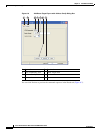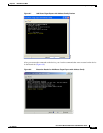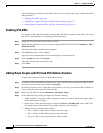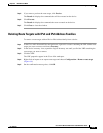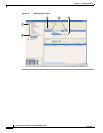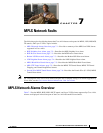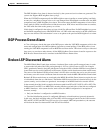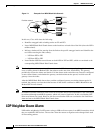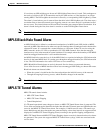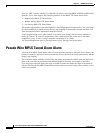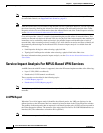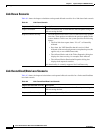
7-3
Cisco Active Network Abstraction 3.6.6 MPLS User Guide
OL-19192-01
Chapter 7 MPLS Network Faults
BGP Process Down Alarm
The BGP Neighbor Loss alarm is detected actively by the system and service alarms are generated. The
system also supports BGP neighbor down syslogs.
When the VNE BGP component polls the BGP neighbor status (expedite or normal polling) and finds
an entry for a neighbor no longer exists or its state changed from Established to another state, the BGP
component issues a BGP Neighbor Loss alarm. This alarm causes the BGP component to issue a Root
Cause Analysis (RCA) correlation flow to find the root cause. If RCA does not find an alarm to correlate,
the VNE sends the alarm to the gateway as a ticket.
If this alarm is configured in the registry to issue a Look For Affected flow. If a BGP neighbor loss occurs
and the BGP component has no other BGP PE links, all VRFs with route entries to the PE as BGP next
hops are true-affected. This information is sent as an update to the previous BGP Neighbor Loss alarm.
BGP Process Down Alarm
A Cisco ANA query checks the status of the BGP process when the VNE BGP component polls for the
status and configuration of its BGP neighbors (expedite or normal polling). If the BGP process is not
running, the VNE BGP component issues an BGP Process Down alarm. This alarm is always a ticket and
does not try to correlate to other alarms. All the BGP Neighbors Down alarms issued in response to the
BGP Process Down alarm and is correlated to the BGP Process Down ticket.
Broken LSP Discovered Alarm
The MPLS Black Hole Found alarm activates a backward flow on the specific untagged entry in order
to traverse the full path of the LSPs passing through it. If Cisco ANA locates services (for example,
VRFs, pseudowire tunnels) along this path that are using these LSPs, a Broken LSP Discovered alarm is
issued. Such services can be found only on PE routers, and they can be found on more than one PE router.
The source of the Broken LSP Discovered alarm is the PE router on which the service was discovered,
and in many cases this router is different from the router that issued the MPLS Black Hole Found alarm.
Broken LSP Discovered alarms are correlated to the MPLS Black Hole Found alarm (except in the case
of a black hole alarm due to a link down). The Broken LSP Discovered alarm is detected actively by the
system, namely, service alarms are generated. An example of an MPLS black hole scenario follows.
In the network described in this example, the shortest path from PE2 to PE3 is PE2<->P2<->PE3. The
link between P2 and PE3 is an MPLS link, meaning interfaces on both sides of the link are configured
as MPLS interfaces. Also assume that for some reason, the MPLS configuration is incomplete or
incorrect, namely:
• Only one interface is configured as an MPLS interface.
• The label distribution protocol is configured differently on both interfaces (protocol mismatch).
In this case, the label switching table on P2 and PE3 will have untagged entries for the LSPs between
PE2 and PE3. If PE2 and PE3 have VPN services (for example VRFs and pseudowires), the outcome
will be that the data flow between PE2 and PE3 will be affected.




